Dive into the heart of Calabria with this robust and flavorful spicy sausage pasta! A traditional pasta recipe from La Sila, a picturesque mountainous plateau in Southern Italy, this dish beautifully showcases the region's traditional ingredients.
It's perfect for spicy food lovers, and the best part? You can bring this Italian classic to your table in under an hour!

History
This spicy Italian pasta recipe, known in Italy as pasta alla Silana, is one of the most well-known pasta dishes from this part of Calabria. This very filling and hearty recipe is full of typical Sila foods. It is actually a pretty popular recipe in other parts of Italy and Calabria, so there are some slightly different versions. However, the main ingredients are mostly the same: tomatoes, sausage, guanciale, porcini mushrooms, caciocavallo cheese, peperoncino and pecorino.
The main differences I found in versions of this recipe was that most called for aged Calabria sausage, without specifying which type. However, one recipe specified soppressata. Since I had some fabulous slightly spicy Calabrian soppressata, I used that.
For those who don’t know it, soppressata is a type of salami made with pieces of lean pork, lardo, black pepper, sometimes a little fennel and peperoncino or sweet red peppers. You can also use other types of Calabrian sausage or salami. I think even chorizo would work.
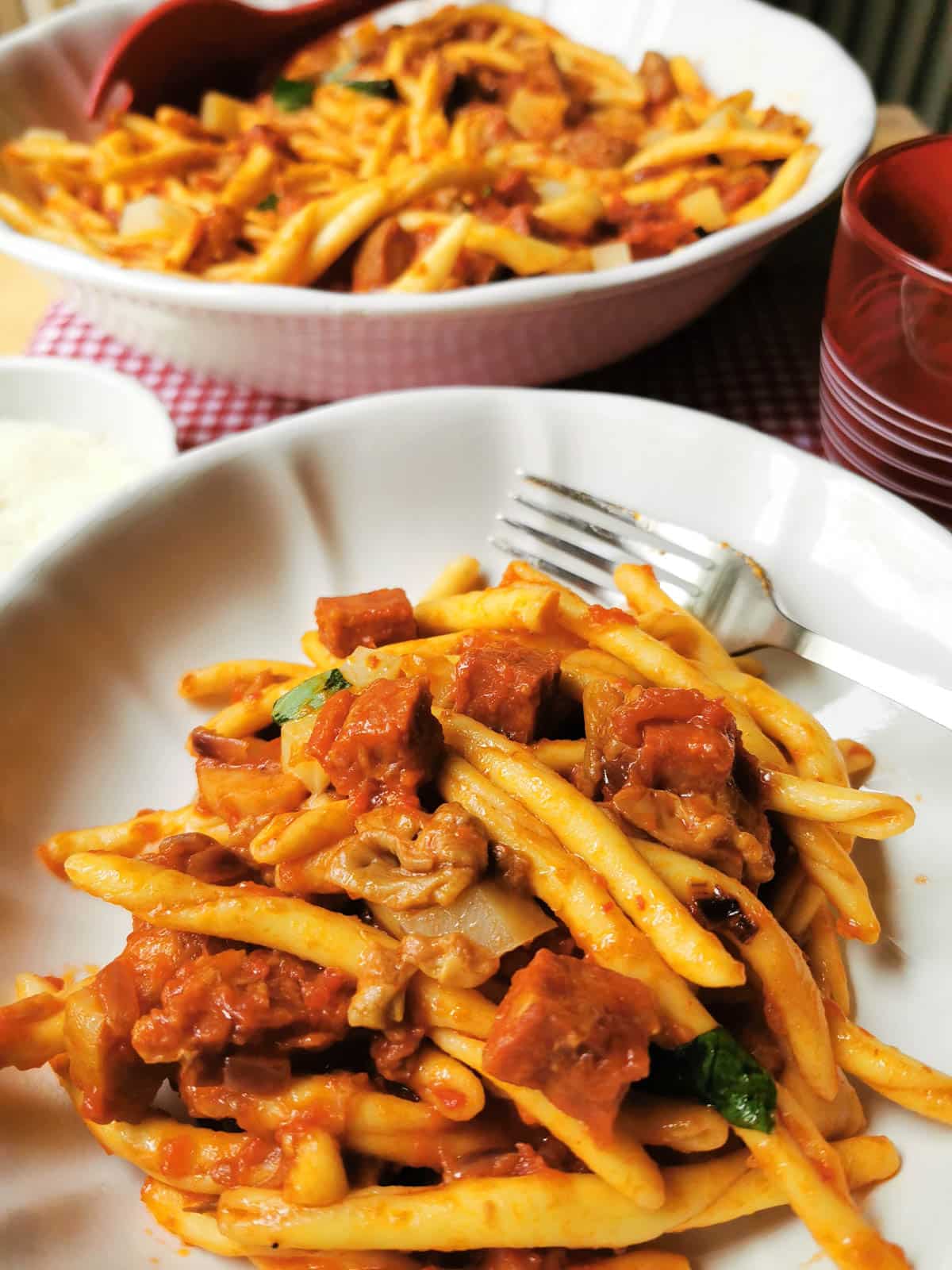
Other variations of pasta alla Silana
Some pasta alla Silana recipes also include prosciutto crudo, but I didn’t add it. If you don’t have any guanciale (pork cheek), you can also use pancetta. I came across a number of versions with it. In addition, not all recipes include porcini mushrooms and when they do, they are usually dried porcini. However, I used frozen porcini.
Also, I was lucky enough to have some caciocavallo Silano cheese from La Sila! This is probably the most well-known cheese from Calabria. The word ‘caciocavallo’ actually means ‘cheese on horseback’! It probably originates from the ancient custom of drying the cheese forms attached in pairs over a horizontal eave or beam. But, you can also use provola, provolone or even mozzarella.
The cuisine of La Sila.
The kitchen of the modern day inhabitants of La Sila is still rooted in ancient traditions. Foraged mushrooms, beans, potatoes, and cheeses (like Silano caciocavallo), chili peppers (peperoncino) and sheep and pig meat are the basis of the Sila cuisine.
Being a mountainous area that was isolated from the rest of Italy, especially in winter, the people of La Sila developed ways to process and preserve food. They are well known for their pork products like soppressata, lardo, capicollo, pancetta, sausages, prosciutto and the typical Calabrian soft spicy sausage nduja. They also pickle mushrooms, grapes, vegetables and olives according to ancient traditions.
Ingredients and Substitutes

- Fileja Pasta: This pasta variety and its distinct shape is excellent at catching the sauce. If you can't source fileja, rigatoni or other short pasta tubes are excellent alternatives.
- Soppressata (Spicy Italian Sausage): This spicy sausage pasta can be made using either the spicy (piccante) or sweet (dolce) version of soppressata. If you're going with the sweet variety, add extra peperoncino flakes for a spicy kick. If soppressata isn't available, other spicy Italian sausages can be used as a substitute.
- Peperoncino Flakes: Control the heat by adjusting the quantity. Modify based on the Soppressata type or other Italian sausage you're using.
- Guanciale: This cured pork cheek adds a rich flavor. If guanciale is unavailable, pancetta or even bacon can serve as alternatives.
- Tomato Passata and Fresh Peeled Tomatoes: I like to use a mixture of fresh peeled tomatoes and polpa or passata. However, you can use just peeled tomatoes or just polpa or passata. In which case, increase the quantity of whichever you use. Double the number of tomatoes or use 50% more passata.
- Caciocavallo Silano Cheese: A traditional cheese from Calabria that is known for its creaminess and distinct taste. If you can't find it, provola, provolone, or mozzarella are suitable replacements.
- Porcini Mushrooms: You can use both dried or frozen porcini mushrooms. If you use dried ones, remember to soak them beforehand.
- Red Onion: Contributes subtle sweetness and depth to the sauce. Yellow or white onions can be used, though they might slightly alter the flavor profile.
- Pecorino: This sheep's milk cheese provides a sharp and salty punch. Parmigiano Reggiano or Grana Padano can be a backup if unavailable, though it will have a less sharp flavor.
- Whiskey: This adds depth to the sauce and deglazes the pan. For an alcohol-free version, water, chicken or vegetable broth can replace it, though the flavor might vary slightly.
- Basil Leaves: Fresh basil brings an aromatic herbal touch. Make sure to use fresh basil and not dried.
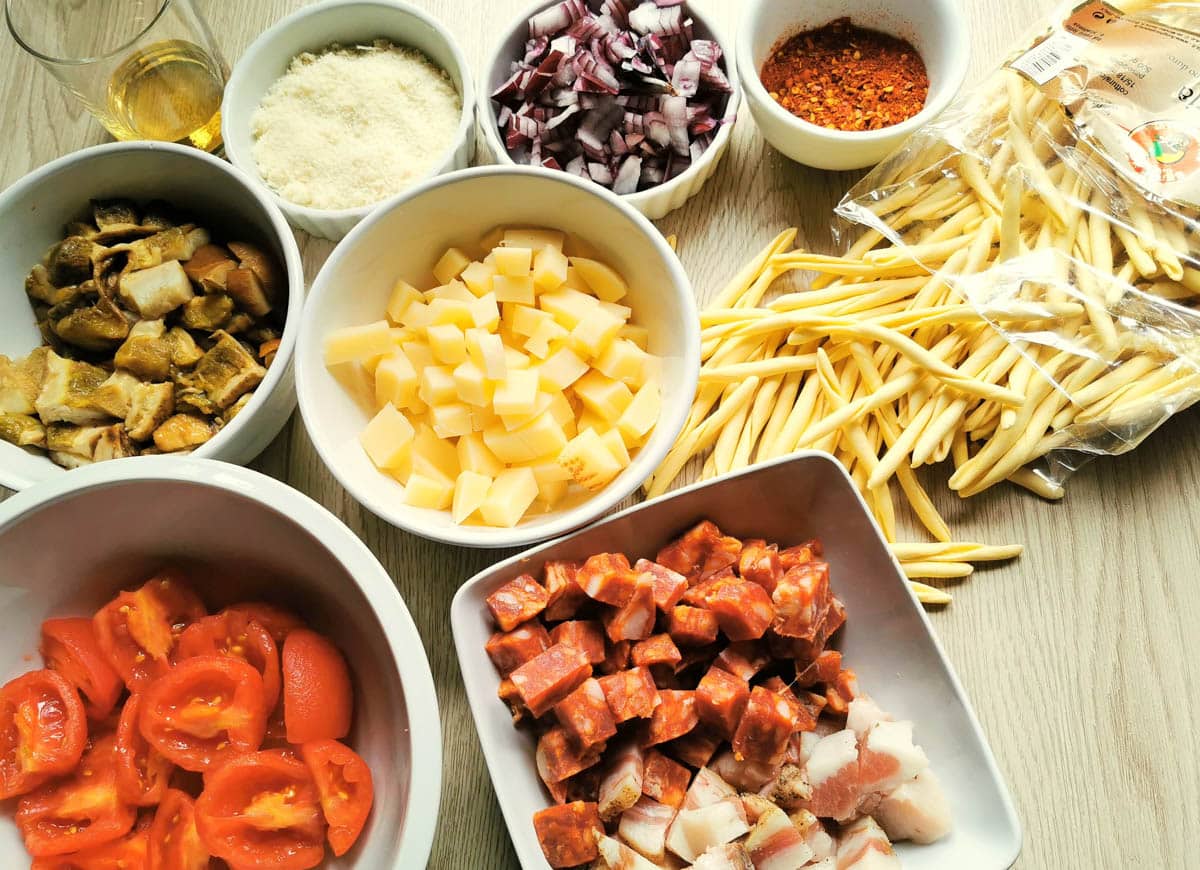
Step by Step Instructions
1) If using dried porcini, soak them in warm water for 20-30 minutes.
2) In a large pan, heat the olive oil. Add the guanciale, soppressata, and peperoncino flakes. Cook until the guanciale fat starts to become translucent. Pour in the whiskey and allow the alcohol to evaporate.
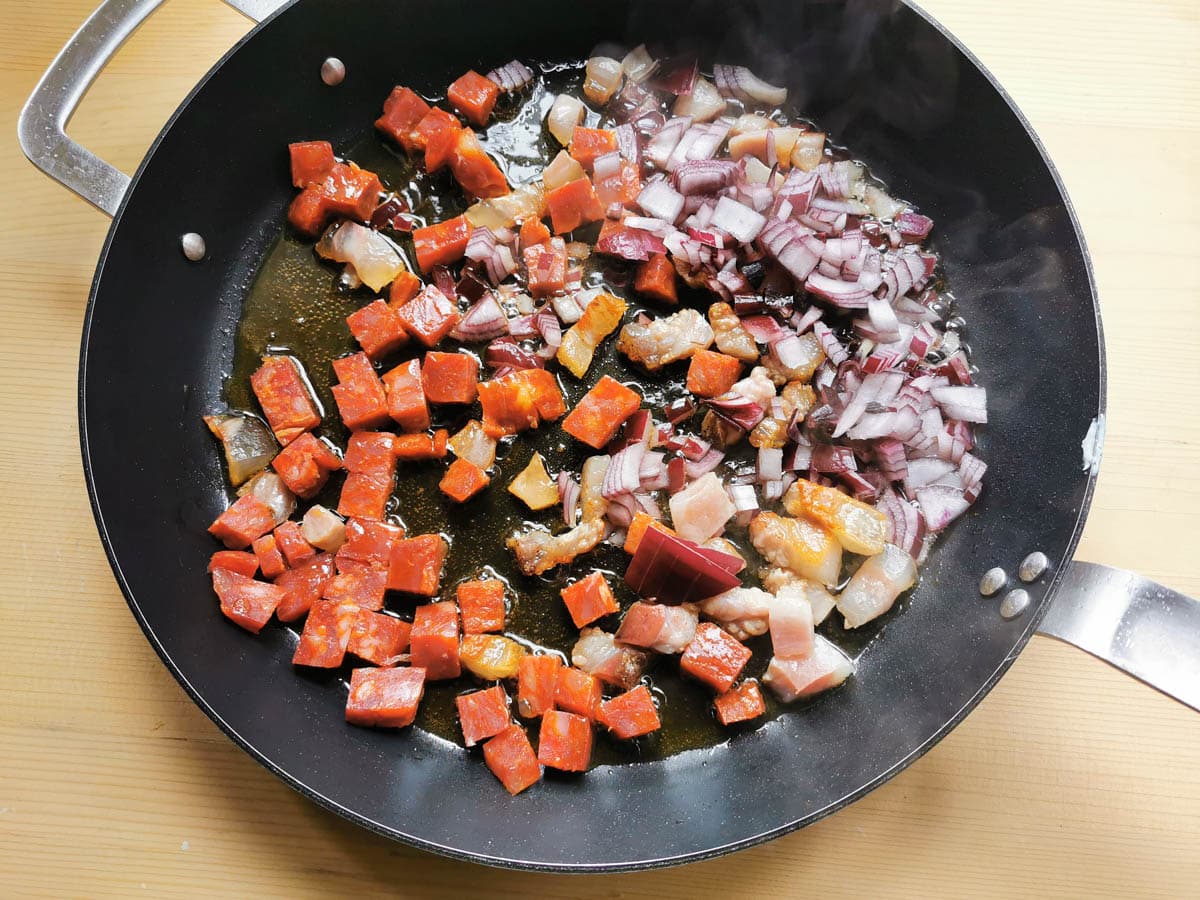
3) As the guanciale turns crispy, add the peeled tomatoes and cook over moderate heat until they start to soften.

4) After mix in the tomato passata until well incorporated.

5) Put a pot of water on to boil for the pasta. Add salt once it starts to boil. Once the water returns to a boil, cook the pasta al dente based on its packaging instructions.
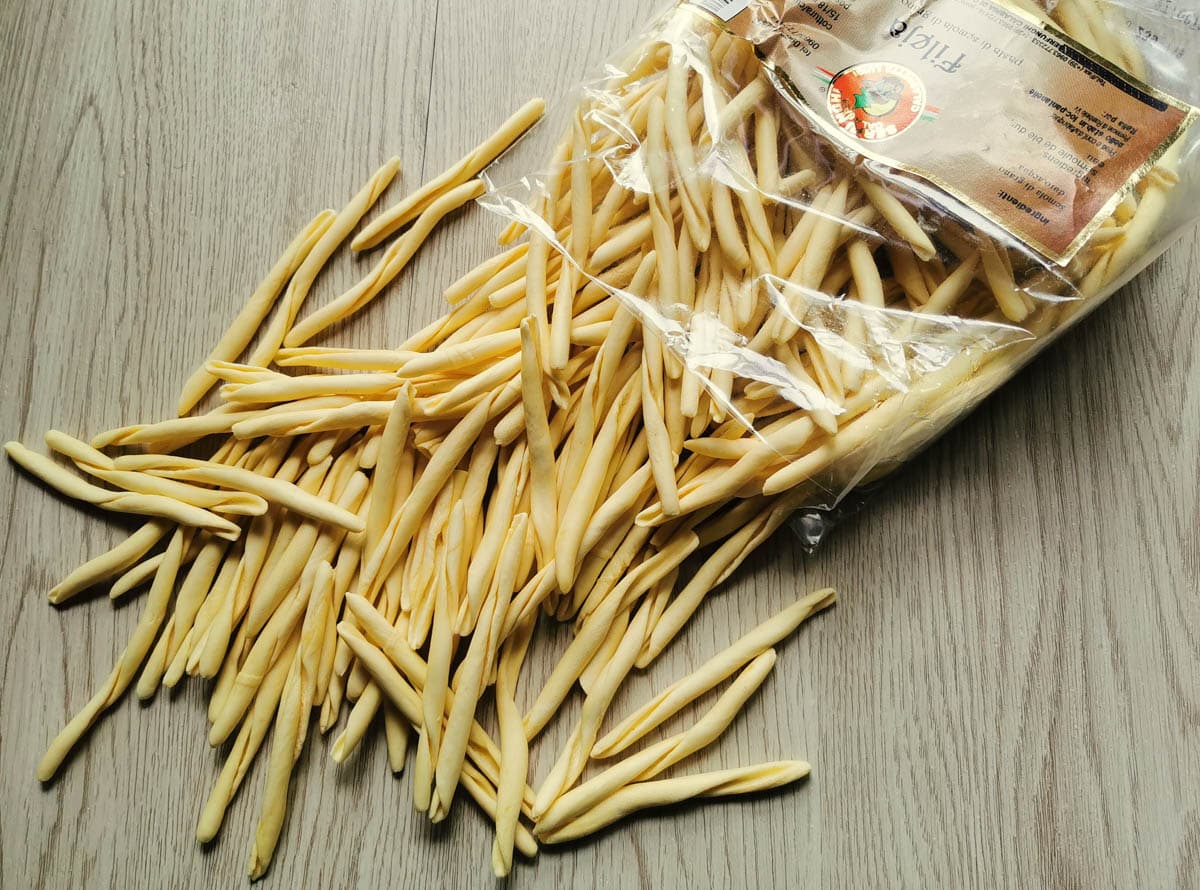
6) Meanwhile, as the pasta is cooking, add the soaked porcini mushrooms and its soaking liquid to the pan with the sauce. Adjust the seasonings with salt and black pepper, and let it simmer on low heat until the pasta is ready..

7) Drain the cooked pasta and mix it into the sauce. Fold in the basil and caciocavallo cheese. Let it sit briefly to allow the cheese to melt slightly before serving.
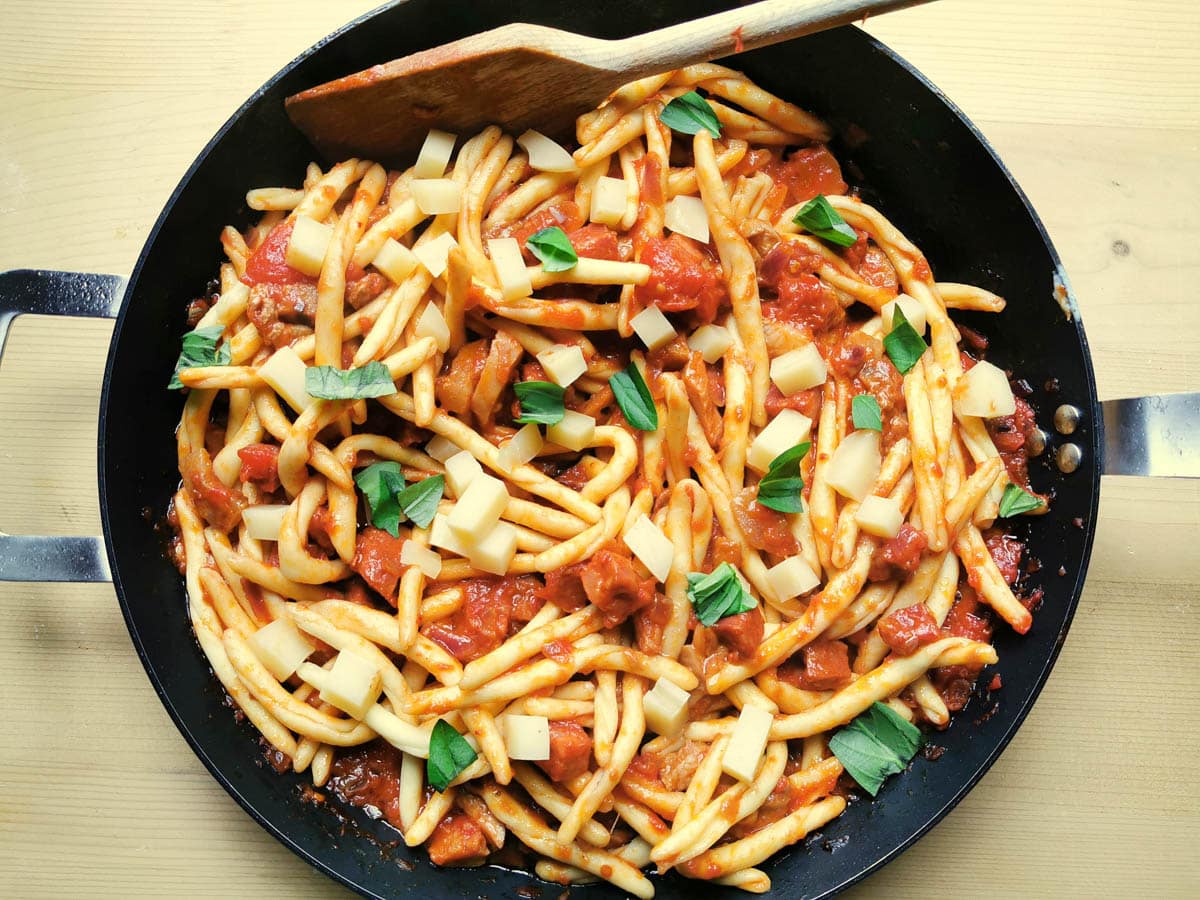
8) Serve the pasta immediately, finishing it off with a sprinkle of grated pecorino.

Storage and Leftovers
Allow the spicy sausage pasta to cool to room temperature before transferring to a storage container. Store the leftover pasta in an airtight container in the refrigerator for up to 3-4 days.
To reheat, transfer the desired portion to a microwave-safe dish, cover loosely, and microwave in short intervals, stirring in between, until heated throughout. Alternatively, you can bake leftovers in a preheated oven at 180°c (356°F) until hot through. Sprinkle with some grated pecorino or Parmigiano before baking.
FAQs
Soppressata is an Italian salami (a fermented and dried sausage) and a specialty in the southwestern Italian region of Calabria. While there are variations, the primary distinction lies between the sweet (dolce) and spicy (piccante) versions.
Pasta alla Silana originated in La Sila or the Sila, a mountainous plateau and historic region in Calabria. This extraordinary territory is the only mountain massif that rises in the heart of the Mediterranean.
While fileja pasta is a very typical Calabrian pasta, it is less common in general supermarkets outside of Italy. However, specialty Italian grocery stores or online retailers often carry it. If unavailable, rigatoni is a good substitute.
More Recipes You May Like:
- Bread Gnocchi with Sausage
- Fileja Tropeana
- Elicoidale with Tropea onions
- Long fusilli with pesto Calabrese
- Tajarin Pasta with Beef Sausage
If you do try this spicy sausage pasta recipe, I’d love to hear what you think. Please write a comment here on the blog or post a comment on the Pasta Project Facebook page.
Your feedback means a lot to me!
Buon Appetito!
Pin For Later:

If you are interested in learning how to make other homemade pasta and different types of gnocchi, check out my shop for some great video online courses from my friends in Rome!
Nothing beats learning to make pasta from Italians! Plus, while you're there, why not order a copy of one of my pasta recipe cookbooks or check out some recommended pasta-making tools?




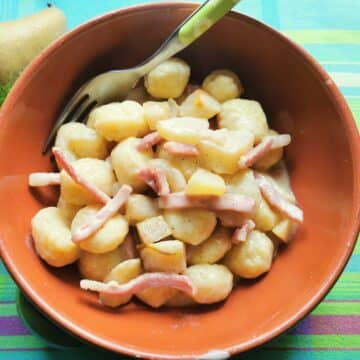

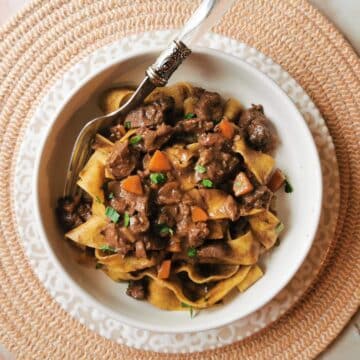
Dave Dixon says
Five-star flavor, but I was left with a chopped onion with nothing to do. Probably should have put it in with the sausage?
That's okay: though I was in Tropea last month, I didn't bring back an onion. So it was just a yellow onion.
I did bring back a jar of Calabrian red chilies, however. Good heat, though mild compared to the home fare here in New Mexico. That's what prompted the search for spicy Calabrian recipes. No caciocavallo here, and good fresh tomatoes are rare, even in season, so I subbed canned San Marzanos.
Love your recipes, especially attention to origins and authenticity.
Vittoria Veltri says
Hi Jaqui, I am Silan girl living in London where I teach pasta making workshops. In the original recipe you use fresh sausage not dried one. The original name of the recipe is Pasta alla Pecoraja.
Jacqui says
Hi Vittoria, thanks for your comment. However, whilst researching this recipe I came across many versions. Some include fresh sausage but others have salsiccia stagionata or salsiccia secca or soppressata, which I used. Here are a couple of links for recipes I found https://www.repubblica.it/sapori/2021/01/26/news/rigatoni_alla_silana_con_salsiccia_secca-284245447/
https://www.piatti-tipici-calabresi.it/fusilli-alla-silana/
I even have a book Cucina Calabrese in which they call for salsiccia stagionata. I think pasta alla pecoraia is another recipe. I haven't made it but found it on this site. It has fresh sausage and fresh ricotta https://www.calabriaportal.com/primi-di-carne/3263-paccheri-alla-pecoraia.html Going to add it to my to-make list!
John says
Thanks so much for the recipe. I love the filei style pasta as it reminds me of a type of pasta she used to make which was popular in the village she came from in Hungary. Since I love trying new recipes, this one caught my attention. I do have a question about the recipe since you say to use whiskey but fail to specify which type to use. There are different types of whiskey made with different types of grain recipes and different distilling processes. The flavor can vary quite a bit between say a Canadian type, a bourbon, a rye, a scotch, or one of the others. Is there a particular type you are referring to?
Jacqui says
Hi John, thanks for your comment. I also like fileja a lot. One of these days I want to make my own. Re the whiskey. The Italian recipe I followed didn't specify the type of whiskey. I used what I had at home at the time, maybe a Jamesons blended Irish whiskey. My hubby is the whiskey drinker and he usually has a stock of Laphroaig single malt at home but I wouldn't use that for cooking this kind of dish! So to make this again I'd go with a blended Irish or Scottish brand or similar. I don't know much about Canadian whiskey or bourbon. But, I will add a note to the recipe.
Kari Alana says
This was such an enriching pasta post to read about and it looks like one of my favourite hand rolled pastas. This is absolutely delectable.
Jacqui says
I'm happy you enjoyed reading this post Kari. This recipe from La Sila in Calabria is so so good. I hope you'll try it!
Donna says
Hi Jacqui, do you think the whisky/brandy is necessary in this recipe? I don’t have any on hand.
Jacqui says
Hi Donna, thanks for your comment. No, I don't think the whiskey/brandy is essential!
Jenni LeBaron says
Calabria sounds like a pretty delicious place! I can get on board with any place that uses such delicious ingredients. This Fileja Pasta alla Silana looks delightful!
Jo says
I love myself a good traditional pasta dish. And your recipe sounds amazing. I love how simple it is to make and the flavors are amazing here.
Jamie says
This made such a wonderful, hearty meal for my family! The guanciale gave this dish so much flavor and I loved reading this history of this dish!
The Pasta Project says
Thank you, Jamie! I am thrilled to hear you made this recipe and loved it!
Amanda says
Love a hearty pasta dish. This recipe is great!
The Pasta Project says
Thank you, Amanda!
Kathryn says
Love the favor combo in this recipe. It looks like such a good cold weather meal!
The Pasta Project says
Thank you, Kathryn. I love a good hearty meal in the cooler months too!
DJ says
Wow, you know it's good when you can't even pronounce the name! Brava! I've never had this but a friend recommended so will have to try.
The Pasta Project says
Thank you, DJ! The j is pronounced like a y!
Lori | The Kitchen Whisperer says
Oh what! What a unique and interesting recipe! It looks so comforting and inviting! Loving the flavor combination!
The Pasta Project says
Thank you, Lori! The tastes and texture of the recipe are divine!
Amy Dong says
I love how you used fileja pasta in this wonderful looking recipe! It's what I'm wanting for Sunday dinners!
The Pasta Project says
Thank you, Amy! It's such a good recipe for a Sunday!
Nicole Washington says
Pasta is my weakness. I love the flavors you have in this pasta dish!
The Pasta Project says
Loving pasta is never a weakness Nicole!